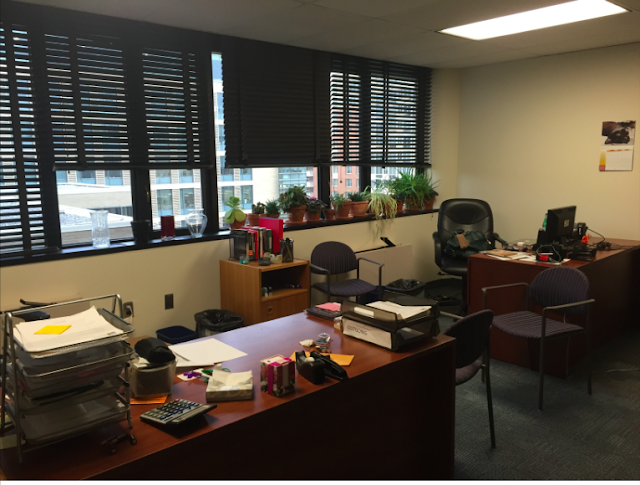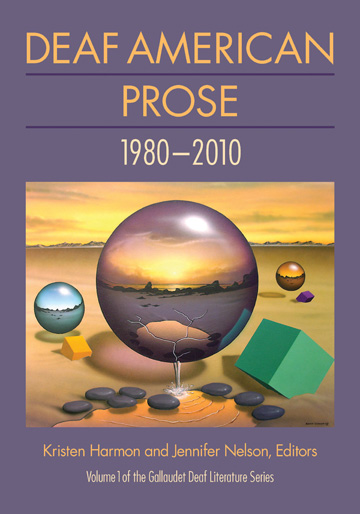 |
GW English Professor
David T. Mitchell |
GW English is already well known for work in Disability Studies, an interdisciplinary field of inquiry examining the meanings of disability in culture and history, interrogating ideas of normality, and continually imagining what a more accessible world might look like. We were thus very excited to search this year for a senior scholar in Disability Studies. Professor David T. Mitchell, whose groundbreaking work with Sharon L. Snyder includes The Body and Physical Difference, Narrative Prosthesis: Disability and the Dependencies of Discourse, and Cultural Locations of Disability, will join us this fall. Professor Mitchell was present this past weekend for the celebration of our undergraduate majors. We asked him a few questions about his work as part of our Introducing New Faculty series.
Tell us about your research.
Most of my research has focused on representations of disability in literature, film, and art. I understand this domain as important because most of us interact with the greatest range of disabled people in imaginative realms such as fantasy, romance, horror, suspense, and memoir. While the disability rights movement has focused on the critical question of social barrier removal in order to achieve more integrated public space, my research has sought to intervene in the more ephemeral arena of belief, attitude, and stigma. Essentially my work has tried to discover ways of countering the historical sequestration of people with disabilities; the cultural denial of the prevalence of disability as human variation rather than deviance; the inaccurate assumption that our own historical moment has thought more deeply and effectively about the place of disabled people in our midst; and, most importantly, the ways in which knowledge of disabled peoples’ points of view have the potential to play a critical role in improving the world in which we live.
This last point is pivotal to my current research. I have a new book manuscript under development titled, The Bio-Politics of Disability. The work focuses on contemporary subjectivities of disability developing within late liberalism (neoliberalism). What happens to our understanding of disability when those living in late capitalist cultures experience transformations as subjects of embodied vulnerability? Our bodies are increasingly segmented between good parts and bad parts and an increasingly commodified medical/pharmaceutical industry promises to shore up the problem zones through various forms of supplementation — the democratization of prosthetics, medications, and products sold to soothe beleaguered late capitalist bodies. We increasingly experience ourselves as embodied beings through encounters with deficiencies we didn’t even know we had, or with respect to disorders surely on the horizon. How does this more diffused sense of vulnerability for all impact people with disabilities in particular?
My research asks questions about what happens to those bodies interpreted as outside norms of health, capacity, functionality, and appearance. What does disability have to do with neoliberal regimes of intensified body maintenance? If the eugenics period approached disability as deviance in need of radical segregation, what differs under neoliberalism when disabled bodies are increasingly treated as data into which medical, rehabilitation, pharmaceutical, charity and public relations industries can tap? Is this an opportunity for a resuscitation of disability’s marginalized social status or paths to further levels of degradation even when compared with the radical institutionalization campaigns of early 20th century eugenics?
We notice you’re teaching Disability Studies in the Fall. Although there have been courses in Disability Studies in the department before, this is the first time this new slot (English 3910) has been used. What do you plan to do with this new course?
One of the qualities that most attracted me to the GW English department was the already-established history of Disability Studies scholarship and course offerings. When I visited as a candidate in March 2013, graduate students told me of their exciting research projects related to Disability Studies (DS). I was excited by the ways in which departmental courses in the Early Modern period and Queer Studies, for example, were already making disability integral to their materials. I’ve served in several administrative roles regarding the development of Disability Studies programs in the past and my belief is that students primarily generate the future research agendas of departments. Thus, I look forward to how students will help me identify the materials and questions they’d like to study following my arrival at GW. This is an important aspect of further deepening DS’s relationship to historical and theoretical movements already richly-positioned in the department and the university at large.
For next fall, I plan to offer a course that focuses on the movement in DS from a rights-based advocacy movement (i.e. social model and identity-based approaches) to one increasingly interested in questions of materiality and subjectivity (what Tom Shakespeare calls “embodied ontology,” Robert McRuer refers to as “the turn to the body,” and Tobin Siebers identifies as “complex embodiement”). The course will focus on interpreting cultural products created by disabled people in a variety of global locales. We will discuss how disabled people living in various parts of the world depict their lives, needs, desires, and alternative social worlds. Often these ways of living are markedly different from those pursued in normative contexts. DS has richly portrayed the ways in which disabled people (of all socio-economic backgrounds) experience radical exclusion, architectural/attitudinal barriers, and historically-layered stigma regarding acceptable bodies. However, what is only recently developing is a way of imagining how disability subjectivity – the queer modes of experience developed by disabled people surviving alongside other marginalized communities – further nuance interdependent options for living with others.
Consequently, the fall course will give students some grounding in social model approaches to disability, identity theory, and the forwarding of media representations to effect social transformations in public attitudes. To accomplish this goal we will look at a variety of disability cultural productions including: novels (Mark Haddon’s The Curious Incident of the Dog in the Night-Time and Richard Powers’s The Echo-Maker), films (John Schlesinger’s Midnight Cowboyand Jenny Livingston’s Paris is Burning), art (the figural portrayals of Riva Lehrer), and internet spaces (cybernetic communities seeking ways of directing medicine toward interventions and supports more sustaining to themselves). How does life in alternative (i.e. normatively-rejected bodies) result in creative ways of navigating the world? In what ways does a more developed understanding of disability enhance our knowledge of the fiction of normative practices and beliefs about bodies in general? How do early 20th-century modernist exchanges about ways to exclude disabled people impact the making of contemporary global disability arts and culture movements on a geopolitical scale at the outset of the 21stcentury?
You’ve been in a number of innovative, interdisciplinary locations over the years; what made you want to join the GW English Department?
The one unfortunate thing that I’ve learned over the course of my career in “interdisciplinary departments” is that they are not, by-and-large, interdisciplinary. There’s a significant amount of rhetoric at universities regarding the importance of interdisciplinary work – teaching, scholarship, cross-disciplinary collaboration – but the reality of implementation is much different. At GW there is already a substantial amount of interdisciplinary work underway. The English department is full of amazingly diverse, cross-disciplinary faculty; the graduate students openly address their research within interdisciplinary contexts; even the Disability Support Services Office imagines its role as much larger than integration and accommodation of students with disabilities and diverse learning styles. This is a rich tapestry in which to bring my own work and one that I believe will continue to feed my future interests. When I applied to GW I was looking for a location that valued Disability Studies as something other than an addition to existing diversity initiatives. The disability historian, Catherine Kudlick, puts the question most succinctly, “why do we need another other?”
This is an incredibly important question in my decision to come to GW. I don’t think we need another other, and, even if we do disability should not be it. These concepts of neoliberal diversity tend to water down the more substantive contributions of meaningful integration. Instead, what I would like to help bring to the department is an investment in making disability integral rather than merely integrated into human social orders. This entails a parallel project that has been underway in Queer Studies wherein scholars have asked what use is an LGBTQ movement without particular discussions of acts constituting queer lifestyles? I take this question to mean, what if we gain a degree of acceptance of LGBTQ people but change nothing about the culture based on their alternative ways of being/living/surviving? How do we bring a more peaceful concept of co-existence with others into existence if we’re not going to forward the content of artful, creative ways of being that queer lives (including disability) entail?
So the opportunity at GW appears rich in possibility to me at this stage of my career and will prove as significant to the development of my future thinking as it will serve as a new home into which to bring my own ideas. I have many colleagues already in the department and new faculty entering alongside me who promise to make the intellectual, social, and working atmosphere stimulating for a teacher/scholar such as myself.
What are you most looking forward to about moving to Washington, DC? What are your thoughts on disability culture and/in DC?
The Metro — the luxury of having access to the most accessible public transportation system in the country, plain and simple. I lived in Chicago for eight years and the brown line train stop on my block did not become accessible to those in wheelchairs until the day I moved to Philadelphia! What a terrific, terrible irony. In Philadelphia the trains were technically accessible but you had to ask a conductor to get a ramp out to board and then make a 90 degree turn through a narrow doorway to enter the passenger car (only the front row of course). Two years later Septa (the Regional Railroad) began purchasing new passenger cars – based on years of activism by the disability rights movement – that had double sliding doors and an onboard ramp that could be operated from inside the train. However, within a month of purchasing these more accessible train cars the SEPTA administration sent out a notice disallowing the use of the internal ramps because “someone drove off the edge of the ramp while disembarking.” Thus, years of waiting for accessible replacement train cars went for naught within a month and the system went back to providing grudging assistance by making conductors get out of the train to set up the manual ramps for egress and egress. So the Metro in DC will prove very liberating; it’s as if one has to move to a city with systemic access built-in already in order to effectively pursue one’s career, lifestyle, and ability to interact with others outside one’s home.
My partner, Sharon Snyder, and I are enthusiastic museum-goers and we plan to take full advantage of the amazing art and history on display in the city and surrounds. I told my 17-year-old daughter (who also has a disability and uses a wheelchair) that living in DC is like turning everyday into a field trip, rather than looking forward to the one day in your junior year when you get to load into a bus and drive to DC with your classmates. I hope that vision of the city will prove meaningful for all of us.
Finally, I’ve worked with many government and non-governmental organizations in DC for many years – DRC (Disability Rights Council), NiDRR (The National Institute for Rehabilitation and Research), DOE (Department of Education), OPSE (Office for Post-Secondary Education), TASH (the national association for assistive technology), and AHEAD (the national association of higher education for people with disabilities). Living and working in DC will allow me to more easily continue work with these important policy groups into the future.
Some of your films have been shown at GW in the past — are you and Sharon Snyder still making films? Are there any that are in process right now?
My research and filmmaking partner, Sharon Snyder, has included me in some of the most important work about disability; namely, our co-creation of four documentary films about the culture, art, and history of people with disabilities. Despite our collaborative work on books, book series, edited collections, journal publications, etc., it has been our films that have made the greatest impact on the dissemination of thinking about disability in higher education. So this is a media we will continue to use as a primary means to perform our work as public translators of academic ideas into opportunities for public engagement.
Right now we are working on two documentary films: the first, begun in 2007 with our friend and artist, Riva Lehrer, details the history of a school built for physically disabled children on the outskirts of Cincinnati, Ohio. Condon School was funded by philanthropists in 1921 to provide a centralized educational experience for children with chronic conditions otherwise restricted to living in hospitals. In addition to providing k-6 schooling, Condon also provided medical, rehabilitation, and dental services. Ironically the school had to add grades 7, 8, and 9 when their students “outgrew” the elementary school offerings. I guess they were supposed to die before reaching their high school years. Over the years, as the school was threatened with funding cuts, administrators expanded the school’s mission to include children with intellectual disabilities and, ultimately, autism, “retardation,” and severe behavioral disabilities. By the 1990s neighborhood demographics had shifted dramatically and the surrounding community became increasingly African American and Latino. Residents argued that having a school for disabled children in their neighborhoods further stigmatized those who lived on the margins of Cincinnati society in predominantly lower class neighborhoods. The school was torn down in 2007. The documentary will chart this ambivalent history of disability-based segregated education and racialization in the U.S.
The second film involves our personal history of medically and socially managing esophageal atresia (EA) with our daughter, Emma. EA results in an esophageal anomaly that involves a complex surgical intervention for successful repair. Over the past 17 years we have met many parents/caretakers of children with EA; nearly all have come from medical contexts that botched the repair surgery because, currently, there is only one surgical solution for a viable correction of the problem but few pediatric surgeons trained in the appropriate technique. This film will discuss the ways in which medical cultures fail to disseminate lifesaving information about surgical interventions on behalf of patients due to corporate healthcare profiteering and lack of medical training about the disorder. The film will also focus on the lack of discussion about how to manage one’s social life with a severe, highly medicalized, digestive condition.
What do you hope your first class for graduate students might be?
I like to tie graduate seminars into current research topics just beginning to be investigated. If I get the opportunity to teach a graduate seminar in Spring 2014, for instance, the course will cover a series of themes on the intersections of Disability, Cross-Species Identification, and Environment. The seminar materials will open up an examination of the shared interests of disability with environmental movements. Both activist agendas require direct redress of the widespread destruction of the planet by global capitalism. In undertaking questions of materialism and disability I hope seminar participants can begin to re-think ways in which marginalized communities (such as migrant workers and lower income communities) and disabled people’s everyday lives involve significant levels of exposure to toxic environments — lives of “slow death” (Lauren Berlant’s key phrase for the toxic experiences of under-privileged communities under neoliberalism). The seminar will also address questions of environmental toxicity with recent theories on the porosity of bodies wherein animate and inanimate particulate matter inevitably cross the semi-permeable encasements within which humans and animals exist. In short, we are the environments we inhabit.
Some important theoretical works I’m thinking of using as reading for the class include excerpts from: Donna Haraway’s Primate Visions: Gender, Race, and Nature in the World of Modern Science; Eli Clare’s Exile and Pride: Disability, Queerness, and Liberation; Stacy Alaimo’s Bodily Natures: Science, Environment, and the Material Self; Mel Chen’s Animacies: Biopolitics, Racial Mattering, and Queer Affect; Martha Nussbaum’s Frontiers of Justice: Disability, Nationality, Species Membership; Elizabeth Povinelli’s Economies of Abandonment: Social Belonging and Endurance in Late Liberalism; Tobin Siebers’s Disability Aesthetics; Alison Kafer’s Feminist, Queer, Crip; and Michel Foucault’s The History of Madness. Likely the seminar will include a novel serving as centerpiece such as Randall Kenan’s A Visitation of Spirits, and/or a memoir such as Dawn Prince-Hughes’s Gorilla Nation: My Journey Through Autism. We will also view select international disability films including: “Sang Froid” (Cold Blood) [France], “Outcasts” [Australia], “Berocca” [United Kingdom], and “Self Preservation: The Art of Riva Lehrer” [U.S.].
Welcome to GW English, Professor Mitchell!







